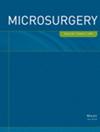Microsurgical breast reconstruction and primary hypercoagulable disorders
Abstract
Background
Primary hypercoagulable disorders pose a significant challenge to microsurgeons and have traditionally been regarded as a relative contraindication to free tissue transfer. Since free flaps offer numerous advantages in breast reconstruction, there is an effort to expand the population to whom these operations can be safely offered. The purpose of this study is to describe our chemoprophylaxis regimen in cases of primary hypercoagulability, as well as to compare flap outcomes and complications between women with and without hypercoagulability.
Patients and Methods
A single institution retrospective review identified 15 patients (25 flaps) with known primary hypercoagulability who underwent microsurgical breast reconstruction from 2010 through 2020. There were 785 patients (1268 flaps) without primary hypercoagulability who underwent microsurgical breast reconstruction, including 40 patients (73 flaps) with a history of venous thromboembolism (VTE), evaluated for comparison. Patient characteristics, thromboprophylaxis regimen, and surgical outcomes were collected. In carrying out this cohort study, we have adhered to Strengthening the Reporting of Observational Studies in Epidemiology (STROBE) guidelines.
Results
Fifteen patients with primary hypercoagulability were identified, including heterozygous factor V Leiden mutation (n = 12), protein S deficiency (n = 1), prothrombin mutation (n = 1), and primary antiphospholipid syndrome (n = 1). Thirteen of these (87%) were discharged with an extended LMWH course. There was no postoperative VTE or mortality in this cohort, and no significant difference in hematoma or transfusion compared with the control group (p = .31, p = .87, respectively). The flap loss rate was 4% in the hypercoagulable group compared with 0.92% in the control group (p = .15). The salvage for arterial or venous compromise in the hypercoagulable group was poor (0% vs. 52%, p = .3).
Conclusion
Microsurgical breast reconstruction in women with primary hypercoagulability disorders is feasible with acceptable risk of flap loss but poor salvage potential. Postoperative thromboprophylaxis with extended prophylactic LMWH in this population appears to be a safe regimen.

 求助内容:
求助内容: 应助结果提醒方式:
应助结果提醒方式:


